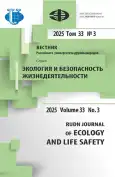Some aspects of adaptation of measuring instruments for instrumental emission control using UAVs
- Autores: Simanovich S.V.1, Gavrilin I.I.1
-
Afiliações:
- Ural State University of Railway Transport
- Edição: Volume 33, Nº 3 (2025)
- Páginas: 312-327
- Seção: Industrial Ecology
- URL: https://journal-vniispk.ru/2313-2310/article/view/324015
- DOI: https://doi.org/10.22363/2313-2310-2025-33-3-312-327
- EDN: https://elibrary.ru/RQQWJP
- ID: 324015
Citar
Resumo
The study is devoted to the problem of adapting measuring instruments regulated for inventory of industrial facilities within the framework of environmental monitoring to be used on the basis of unmanned aerial vehicles (UAVs) for making measurements remotely in real time. The research considers the possibility of modifying existing measuring instruments by means of technical and software solutions as an alternative to the development of new specialized instruments integrated with the UAV design. Special attention is paid to the influence of external factors and conditions on the accuracy of measurements. In particular, the results of the experiment to study the oscillations of the sensitive elements of the device “Meteoskop-M” at different levels of vibration impact are analyzed. The measurement errors caused by dynamic loads are analyzed, and the necessity of using mechanical stabilization and damping devices, as well as algorithms of digital data correction is justified. On the basis of comparative analysis the advantages and disadvantages of the existing approaches to the implementation of the technology of inventory of industrial facilities using UAV-based measuring devices developed by the authors are revealed, the efficiency of their use in different operating conditions is considered. The conclusion is substantiated that the adaptation of serial devices through the implementation of engineering solutions taking into account the UAV flight conditions, in particular - vibration effects, is the most rational solution at the moment, and the accumulated experience will allow in the future to develop a new generation of measuring instruments integrated with the UAV carrier platform. The article is aimed at specialists in the field of environmental monitoring as it relates to the inventory of industrial facilities polluting the atmospheric air.
Sobre autores
Semyon Simanovich
Ural State University of Railway Transport
Autor responsável pela correspondência
Email: rewriters@yandex.ru
ORCID ID: 0009-0005-7408-9858
Código SPIN: 5094-6745
Researcher, Occupational Health and Safety Engineer; Postgraduate student
66 Kolmogorov St, Yekaterinburg, 620034, Russian FederationIgor Gavrilin
Ural State University of Railway Transport
Email: i.gavrilin@list.ru
Código SPIN: 2526-2048
Cand.Sc.(Biology), Associate Professor of the Department “Technosphere safety” 66 Kolmogorov St, Yekaterinburg, 620034, Russian Federation
Bibliografia
- Moiseeva AA. Opportunities of modern engineering and environmental surveys. Issues of Modern Science: Problems, Trends and Prospects: Proceedings of the VII International Scientific and Practical Conference, Timed to the Year of the Teacher and Mentor. Novokuznetsk, December 08, 2023. Kemerovo: Kuzbass State Technical University named after T.F. Gorbachev Publ.; 2023. p. 265-267. (In Russ.) EDN: UIVWFR
- Romanova MA, Trefilov PM, Shevchenko AV., Ishakov AJu, Mamchenko MV, Ishhuk IN, Dolgov AA. Monitoring of ecological conditions of the environment using UAVs. Management of Large-Scale Systems Development MLSD’2019: Proceedings of the Twelfth International Conference. Moscow, October 01-03, 2019. Moscow: Institute of Management Problems named after V.A. Trapeznikov RAS Publ.; 2019. p. 1072-1074. (In Russ.) https://doi.org/10.25728/mlsd.2019.1.1072 EDN: RVINFL
- Adamyan DA, Ashikhmina TV. Applications of UAVs for environmental monitoring. Student Scientific Forum 2024: Collection of Articles of the XII International Scientific and Practical Conference. Penza, May 27, 2024. Penza: Nauka i Prosveshchenie (IP Gulyaev G.Yu.) Publ.; 2024. p. 62-65. (In Russ.)
- Kalensky AV, Zvekov AA, Borovikova AP. Patent No. 2816093 C1 Russian Federation, IPC G01N 33/00. Method for determining carbon dioxide emission: No. 2023119704: filed 26.07.2023: published 26.03.2024. Applicant: Federal State Budgetary Educational Institution of Higher Education “Kemerovo State University”. (In Russ.)
- Haske B, Rudolph T, Bernsdorf B, Pawlik M. Innovative Environmental Monitoring Methods Using Multispectral UAV and Satellite Data. First Break. 2024;42:4147.
- Legovich YS, Efremov AY, Fateeva YG. Modern approaches to solving the problem of detecting a point source of atmospheric air pollution using unmanned aerial vehicles. Management of Large-Scale Systems Development MLSD’2018: Proceedings of the Eleventh International Conference. Vol. III. Moscow, October 01-03, 2018. Moscow: Institute of Management Problems named after V.A. Trapeznikov RAS Publ.; 2018. p. 276-284. (In Russ.)
- Yageldin SI. Autonomous atmospheric station based on multirotor UAV for environmental monitoring. New Information Technologies: Abstracts of the XX International Student Conference-School-Seminar. Sudak, May 17-23, 2012. Sudak: Moscow Institute of Electronics and Mathematics, National Research University Higher School of Economics Publ.; 2012. p. 209-211. (In Russ.)
- Pudalov AD. Unified measuring scheme of the analytical control devices. Modern Technologies. System Analysis. Modeling. 2011;(3):220-223. (In Russ.)
- Vavilov VD, Sukonkin AN. Review of domestic and foreign ice detectors. Proceedings of R.E. Alekseev NSTU. 2013;(4):297-310. (In Russ.) EDN: SEZXGN
- Zyazev BYu, Gutorova NV, Lyubskaya OG. Modern information technologies in public ecological monitoring. Problems of Contemporary Science and Practice. Vernadsky University. 2023;(3):36-47. (In Russ.) EDN: OOAGWS
- Kremcheev EA, Danilov AS, Smirnov YuD. Metrological support of monitoring systems based on unmanned aerial vehicles. Zapiski Gornogo Instituta. 2019;235:96-105. EDN: WABBWQ
- Verbeke J, Debruyne S. Vibration analysis of a UAV multirotor frame. Proceedings of ISMA. 2016. Available from: https://past.isma-isaac.be/downloads/isma2016/papers/ isma2016_0797.pdf (accessed: 07.04.2025).
- Goncharenko BI, Kuzmenkov VYu, Kotov AN. Experimental study of the peculiarities of the formation of the noise spectrum of the unmanned aircraft. Noise Theory and Practice. 2020;6(4):49-59. (In Russ.) EDN: CAHHFA
- Gu P, Ausiyevich AM, Lobaty AA. Mathematical model for assessing the influence of vibrations for multicopter elements. System Analysis and Applied Informatics. 2024;(1):37-42. (In Russ.) https://doi.org/10.21122/2309-4923-2024-1-37-42 EDN: TPPEKS
- Sukonkina ML, Gainov SI. Overview of the methods and devices of devices board vibroprotection. Transactions of NNSTU n.a. R.E. Alekseev. 2013;(4):311-319. (In Russ.) EDN: SEZXGX
- Xiaoyu Sh, Yuanhang L, Ligang C, Xin Z. Research and design of UAV environmental monitoring system // Advanced Hybrid Information Processing. 4th EAI International Conference, ADHIP 2020, Binzhou, China, September 26-27, 2020, Proceedings, part I. 2021:11-17.
Arquivos suplementares









